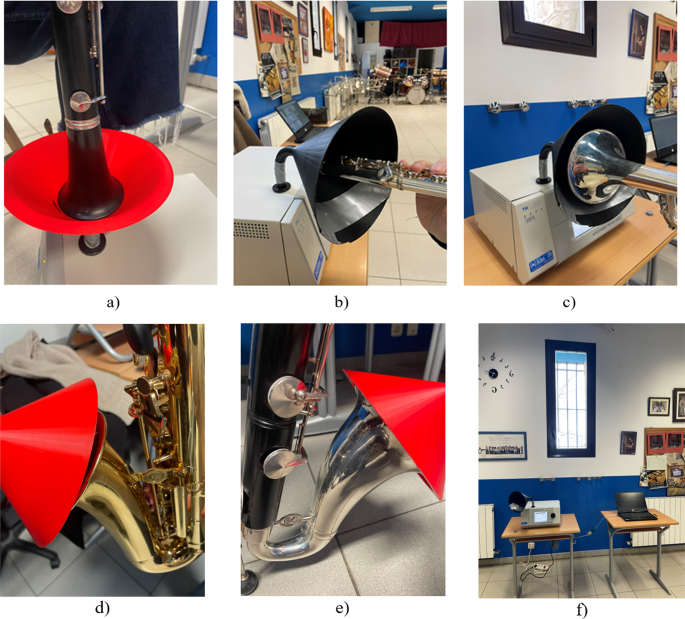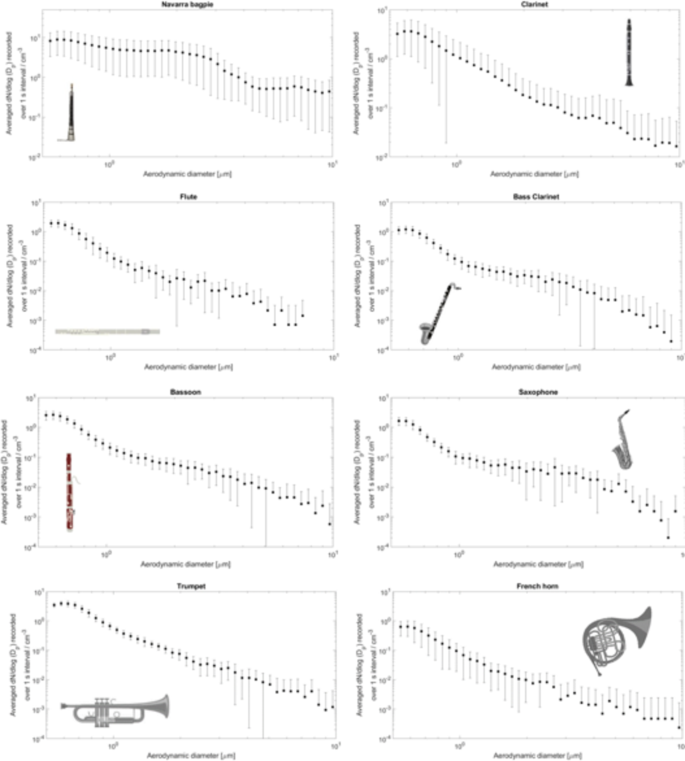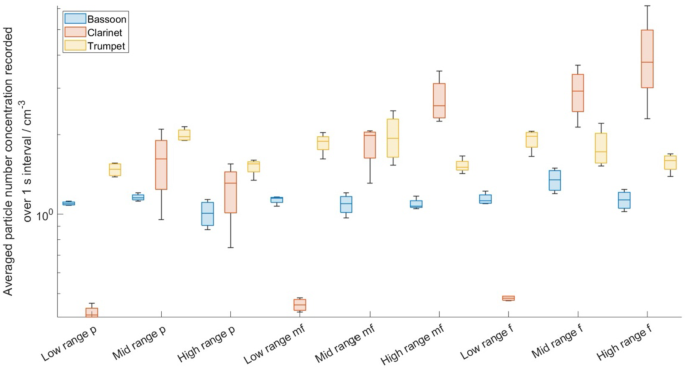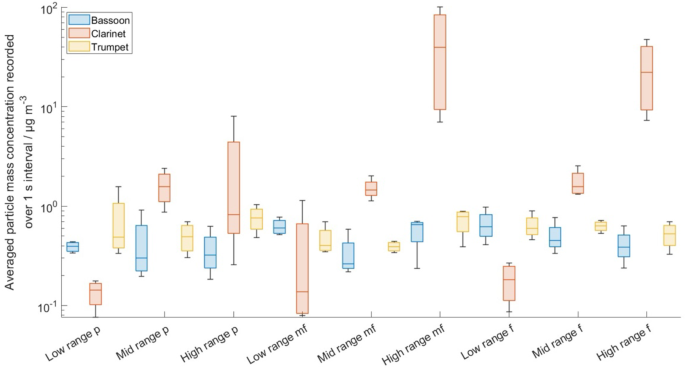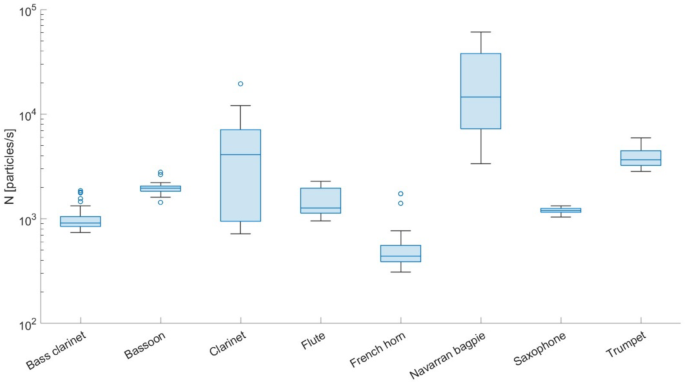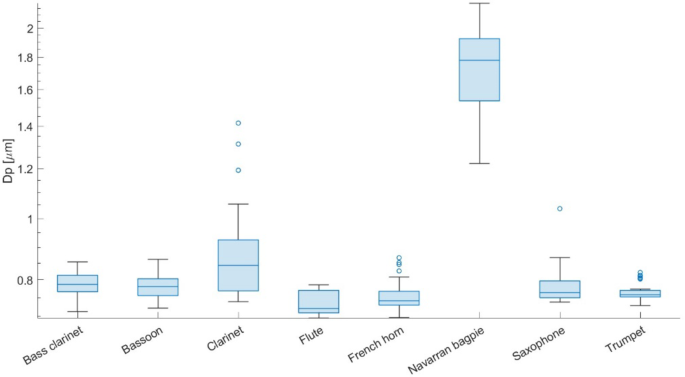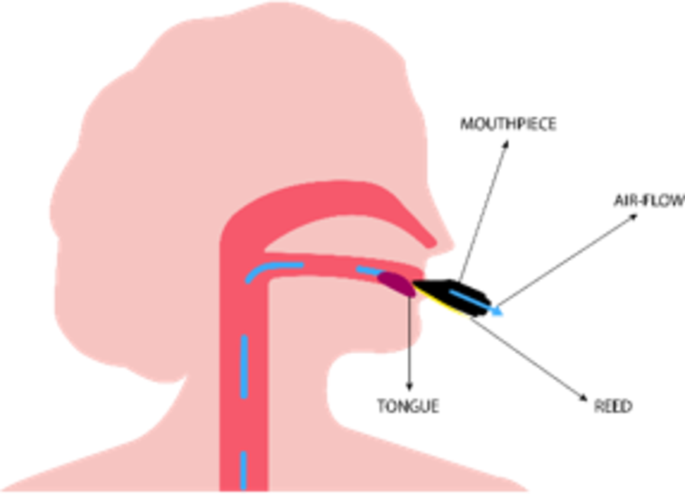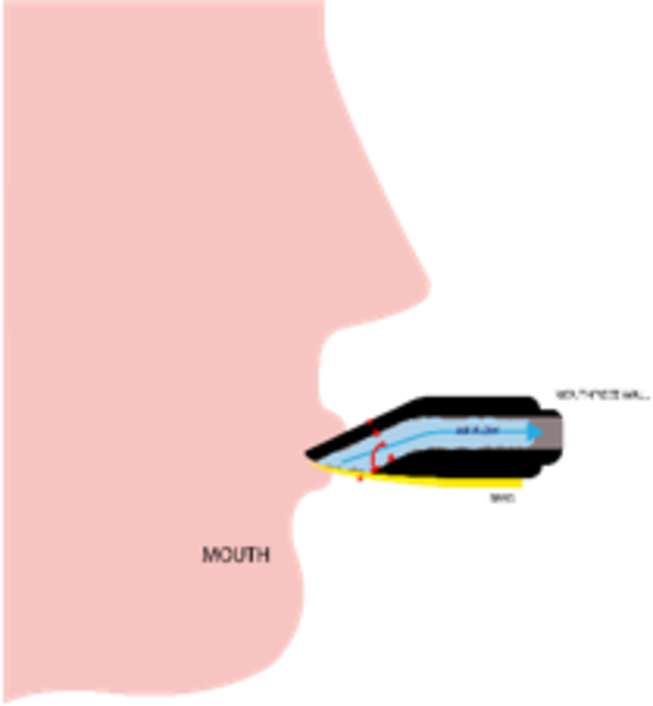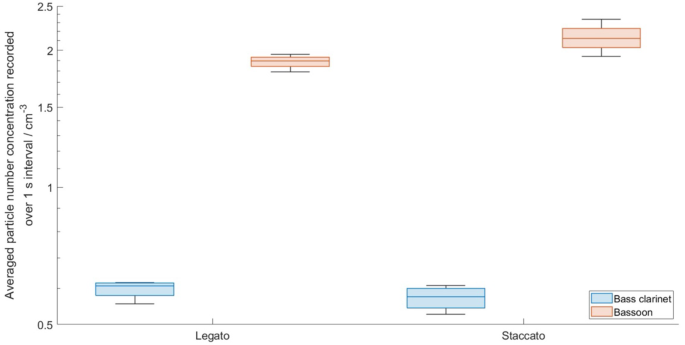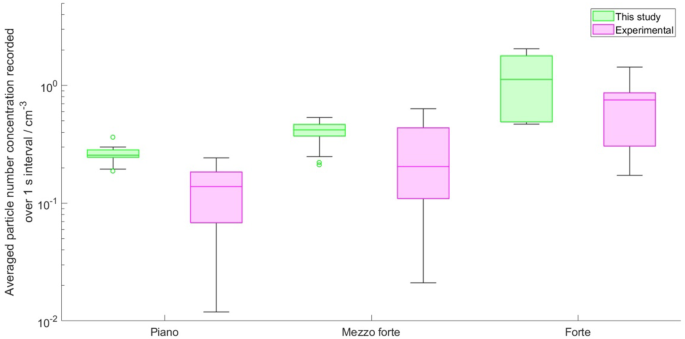Experimental data on aerosols exhaled into the environment from different wind musical instruments
January 8, 2025
Abstract
Brass bands that include wind instruments are heavily affected by rules established during the pandemic. The aim of this experimental work was to assess the aerosols emitted through different wind instruments. The Aerodynamic Particle Sizer (APS) was used to measure the aerosols emitted and transmit those characteristics to a database. The results revealed that the dynamic level at which a note is produced, regardless of whether it is a clarinet, trumpet, or bassoon, significantly changes in aerosol concentrations emitted. Specifically, if there is a higher dynamic level, an increase in emissions of particle concentration will occur by comparing the levels piano, mezzo forte, and forte. These aerosols are produced with a diameter of approximately 0.8 μm, except for the Navarra bagpipe, which has a diameter of 1.8 μm. In addition, this last instrument is the one that emits more particles every second, reaching a value five times larger than that with two reeds, such as the bassoon. Staccato and legato are two well-known techniques among musicians that help in articulating a musical piece. The difference between the two methods in terms of the concentration of the number of particles is not remarkable and is almost negligible.
Introduction
Brass bands constitute one group that has been hit hard by regulations imposed to prevent the spread of airborne viruses. The placement of musicians on stage, as well as the direct direction toward the audience, has tightened the regulations to reduce the spread of viruses. French horns and saxophones emit a plume at a distance of approximately 0.3Â m1. In contrast, flutes reach a distance of more than 1.2Â m. Other instruments, such as clarinets and trumpets, emit clouds that reach horizontal distances between 0.8Â m and 1Â m, respectively2,3.
Regardless, the emitted clouds do not provide the same data on distance travelled as aerosols do. The air mist that is exhaled into the environment after a breathing action is loaded with droplets. In the study by Spahn et al.4, the aerosols behaviour emitted by wind instruments was studied, authors concluded that at a distance of 2 m from the bell of the instruments, the velocity at which the aerosols move was of 1 m s-1. Furthermore, Viala et al.,5 reported that many supermicron (≥ 1 μm) particles remained on the walls of the instruments. However, the outlet of each instrument is positioned in different directions, and depending on external forces, those aerosols will have one direction or another since aerosols are particles with high capacities to affect their first state. In addition, environmental conditions have a direct effect on the transport and droplets behaviour (Ugarte-Anero et al.6,7,8). Stockman et al.9 added that instrument output columns can be defined as directional, unstable, and variant in time and space; this is why they throw an infinite number of aerosols at their viewers and themselves. Understanding the aerosols behaviour has a major influence on change and public health. This statement is supported by the study conducted by Partanen et al.10. The study unites three variables: aerosol emissions, global warming and mortality. It is concluded that reducing aerosol emissions implies an increase in warming. However, reducing aerosol emissions decreases mortality.
Brosseau et al.,11 used artificial fog to simulate air injected by a human playing an instrument, a laser sheet and a high-speed camera reported that the size distribution produced by wind musical instruments was comparable to the size distribution produced by speech12. The respiratory action of speech produces the highest emission rates of particle number and mass, followed by playing wind musical instruments13. If the configuration used to study the aerosols behaviour is an optical particle sizer (OPS) Type 3330 and a scanning mobility particle sizer (SMPS) Type 3910 at the nanoscale14, the results are obtained on the risk of infection, where it is observed that playing a musical instrument incurs less risk than other types of respiratory emissions by humans. Instead, by observing the particles per second emitted by different instruments, the experimental investigation carried out by Firle et al.15 revealed that the aerosol emission ranged from 11 ± 288 particles/second. Additionally, a significant proportion of aerosols (approximately 80%) fall within the diameter range of 0.25–0.8 μm. Wang et al.,1 provided more detailed information on the emission rate of aerosols, and reported that the jet stream emits 20 particles/s, whereas the clarinet emits 1658 particles/s. The flute emits 74 particles/s and about three times less than that emitted by a clarinet, and the trumpet emits 432 particles/s. The other instruments analysed in this study produce approximately 300 particles/s.
There are studies that used the aerodynamic particle sizer (APS) to visualize different parameters of aerosols emitted by wind musical instruments. This tool provided information about the aerosols emitted by the bells of different instruments. Thus, if musical instruments emit particles as they create music, the manner in which changes in dynamic level and articulation, among other actions affect the generation of aerosols can be observed16. For example, Tian et al.17 noted in their experimental study that an increase of one decibel increases the concentration of aerosols. The ratio obtained is 1 dbA, per 10% increase. The results obtained by Abraham et al.18, used the APS with different configuration, showed that when the tone of sound was increased, the aerosol concentration was increased.
The aim of the present study was to obtain experimental values of aerosols emitted by wind musical instruments. Eight different instruments were used to determine the size distribution, mass concentration, particle number concentration, number of particles emitted each second and aerodynamic diameter. The difference between the geometry of these instruments and the mouthpiece used by each instrument should be observed. This research offers the novelty of one of the authors having studied the Navarra bagpipe, an unusual instrument for the world but popular in Spain. Additionally, as a novelty, the differences between producing aerosols via the staccato technique and the legato technique with two instruments with different mouthpieces were clarified and studied.
Methods
Methodology
The aerodynamic particle sizer spectrometer serves, among other things, to characterize aerosols19. This device has an exact simple configuration (see Fig. S1). After the APS is calibrated, it is put into operation. In our case, the calibration was performed together with the company that provided the department with this instrument. Therefore, the results and their accuracy are assured by the manufacturer.
Studies have revealed that larger aerosols fall to the ground quickly upon expulsion. Therefore, droplets with an initial diameter of less than 45 microns are more dangerous, as they can be transported over longer distances and decrease in size in a few seconds to a range of 5–15 μm20,21,22,23,24,25. In fact, particles with a smaller diameter have more contagious power as they have evaporated water and are laden with more residue26. For this reason, the APS Model 3321 has been the tool chosen for the display of aerosols emitted by different musical wind instruments, as it provides information on aerosols with a diameter between 0.5 and 20 microns as they pass through the laser of the device.
Experimental set-up
The instruments tested have produced aerosols through exhaled air. These aerosols contain respiratory particles, saliva, and oral bacteria that enter the instrument. A funnel installed in the inlet nozzle of the APS has been used to collect such aerosols27,28,29,30 (Fig. S2). Only the aerosols emitted by the bell of each instrument have been collected, ignoring those emitted by the mouth and the keys and/or buttons, as most aerosols are exhaled into the environment by the final piece of the instrument, which has a higher output. The bell was directly inserted into the different funnels used for the study (see Fig. 1(a), (b), (c), (d) and (e)). Depending on the size of each bell, the funnel used has different measures16. Figure 1(f) shows the final design of the experiment, which has the same configuration as McCarthy et al.31 and He et al.16.
Setup of the experiment (a) clarinet bell inserted into the funnel, (b) flute bell inserted into the funnel, (c) trumpet bell inserted into the funnel, (d) saxophone bell inserted into the funnel, (e) bass clarinet bell inserted into the funnel and (f) configuration of the test. The laptop, funnel and APS can be seen. The subjects provided written informed consent for the publication of the images.
The space in which all the measurements were taken was the music academy of the municipal band of Laguardia (Basque Country, Spain). The production of aerosols may vary depending on environmental factors, which is why it has been possible to establish an ambient temperature of 20 °C and a relative humidity of 45% sowing to the implementation of an air treatment system carrying HEPA filters16. The controls of temperature, relative humidity and aerosol concentration were the same as those used in Asadi et al.,27 and He et al.16. The HEPA filters were positioned on the sides of the APS. This indicates that the particles in the room susceptible to detection by the APS have been removed, resulting in a background particle concentration of 0 cm-3. In addition, the temperature and humidity of the environment can be controlled by having humidifiers within its configuration and thermometers that control the temperature by activating ventilation to achieve a stable temperature. Therefore, it can be assured that the data processed and shown in this study come from the direct emission of the instruments. Furthermore, the study by He et al.16 indicated that covering the funnel with the instrument hood also prevented the entry of aerosols presents in the room. As indicated by McCarthy et al.31, once the activity, in this case, the action of probing the instrument, was stopped, the APS returns a signal with an aerosol concentration of 0 cm-3 since, owing to the air treatment system, the background particles are constantly removed.
Participants and instruments
The participants in this study were musicians in the small municipal band of Laguardia (Basque Country, Spain) that was composed of approximately 40 musicians of all ages. Although the band was composed of more than 20 instruments, for this project, 8 instruments were chosen. These instruments can be classified into 4 large groups: bass instruments (trumpet and French horn), air-jet instruments (flute), double reeds instruments (Navarra bagpipe and bassoon) and single-reed instruments (saxophone, clarinet and bass clarinet). These instruments were chosen for the study because they are the most abundant instruments in musical bands. Similarly, the saxophone, clarinet and flute are the instruments that are placed in the front row at the time of giving a concert, being the most interesting to study since they are exposed to the people. The Navarra bagpipe is a somewhat unusual instrument, but it is extremely popular in the Navarre community, as well as in the autonomous community of the Basque Country. This instrument can be seen in one of the most famous festivals worldwide, San FermÃn (Pamplona, Spain). Fig. S3 shows the geometry of each instrument mentioned.
At the time of conducting the study and obtaining different samples, two people played the clarinet, bass clarinet, saxophone and trumpet. Therefore, the data obtained from these instruments are more general and representative; this is important to keep in mind, as sprays can vary according to the individual’s playing style and saliva generation. The latter factor tends to affect the results the most. However, the Navarra bagpipe, French horn, bassoon and flute were played by only one person, with a total of 12 participants. Importantly, the maintenance of the instruments can also be a factor affecting the production of sprays. As indicated above, the temperature and relative humidity were set to be stable throughout the test such that the environmental conditions of the location had as little effect as possible on the variation in the results.
The consent of all participants was obtained before they participated in the study. The Institutional Review Board of the University of the Basque Country (UPV/EHU) approved this study, and all the research was conducted in accordance with the relevant guidelines and regulations. In fact, a previous written questionnaire was completed that included age, sex, weight, smoking status, and signed consent to publish the data.
Instrument measurements
Two different tests have been designed to study the emission of aerosols through wind musical instruments. First, a long note must be played for 20 s. This time value is the same as that set by Tian et al.,17 and He et al.16 in their studies. The musicians must play three notes in different ranges: low range, middle range and high range. The notes provided by each instrument are listed in Table S1, similar to the results of the study by Tian et al.,17. The second test assesses the ability to perform the musical scale for 10 s, first legato and then staccato. This time value was set for further organization by observing the average time it took the musicians to perform on the musical scale. All the measurements were taken at three different dynamic levels: piano, mezzo forte and forte. Four different samples were taken from all the measurements. Table 1 shows a summary of the tests described and performed.
Statistical analysis
The software used for data visualization was Aerosol Instrument Manager Software32. All the data collected were considered; specifically, all aerosols of different diameters were measured. However, studies such as Asadi et al.,33 and Johnson et al.,34 focused on particles with diameters between 0.523 μm and 20 μm. The data collected were exported and analysed after the study was performed. All the data fell during the second event; that is, the diameter of aerosols ranged from 0.5 to 20 μm. Therefore, the only difference shown in our results is the visualization of particles with a diameter that oscillates between our first value of the range and its first value of the range. Once the data were exported, MATLAB commercial code was used to interpret the data collected.
The figures shown in the results section are box-and-whisker plots. In the graph a packet is plotted that supplies a series of data. Everything within it refers to the interquartile range (IQR). The lower part is represented by the first quartile (25%), and the upper part is represented by the third quartile (75%). Each end of the IQR is attached to the whiskers that connect the hinge to the maximum or minimum nonoutlier atypical value. Atypical values are all data that exceed a certain value of 1.5IQR. In the added figures the outliers are marked with circles. The bar inside the IQR reflects the meaning of the data. However, the size distribution measured with the APS is fitted via log-normal distributions, as performed in the study by He et al.16. Aerodynamic diameter is described as the diameter of a spherical particle with the density of a water droplet having the same settling velocity as the measured particle. The density in this case is 1000Â kg/m3.
Results
Size distribution of each musical instrument
Over time, experts in music have been designing the geometry for each instrument. This geometry is subject such that the piece of music emits a sound that must be tuned to a note of the musical scale. Therefore, wind musical instruments differ from each other in size and technique; because of this, they generate different values and characteristics, which are analyzed below.
Like respiratory actions, musical instruments generate a sizes distributions depending on the intensity of the action performed. Figure 2 shows particle distributions generated from different musical instruments. The Navarra bagpipe has the highest particle concentrations of all the aerodynamic diameters studied, followed by the clarinet. In contrast, the French horn has the lowest particle concentration. The size distributions of the other instruments analysed tend to be similar, accumulating a number of particles between 100 cm− 3 and 101 cm− 3 in the smallest aerodynamic diameter analysed. This value decreases as the aerodynamic diameter increases. Finally, it should be noted that all the instruments reached a higher concentration in the smaller particles studied, whereas the Navarra bagpipe achieved linearity in the middle of the range studied.
Aerosol particle number and mass concentrations of the instruments at different dynamic levels
The dynamic level refers to the intensity of a note. When you want to deliver a note at the piano dynamic level this results in a soft note. Increasing the sound of a note and the intensity when playing it, you go from piano to mezzo forte. Increasing that sound even more would move the note to forte. Figure 3 shows in detail the particle number concentration depending on the dynamic level for the trumpet, clarinet and bassoon. These three instruments have been chosen since each one belongs to a different type of family, differentiated by the cane or mouthpiece. In addition, the geometries presented by each of them differ greatly from each other. The trend of all three instruments was that as the dynamic level within a note increased, the concentration of the particle number increased. With the clarinet, the above explanation was highest, followed by the trumpet. Within the same dynamic level, varying the note, the mezzo forte level had the highest particle concentration.
Figure 4 shows the mass concentration for the same instruments. The mass concentration emitted by the clarinet is quite different from that of aerosols emitted by the other two instruments. The trumpet yielded a mass concentration ranging 0.4–0.75 µg m-3, and that of the bassoon ranged from 0.3 to 0.65 µg m-3. Instead, the clarinet has a low-range piano value of 0.13 µg m-3 and can produce high tones up to an average of 46 µg m-3. For greater accuracy of both the particle number and mass concentration, refer to Table S2 and Table S3 of the supplementary material.
Similarly, these results were achieved by setting specific boundary conditions, as has been explained in the previous sections. Studies in the literature indicated that increasing ventilation methods could reduce the concentration of SARS-CoV-2 laden aerosols in enclosed spaces35.
Particles per second ejected from each instrument
As shown in Fig. S3, the different musical wind instruments presented in this work have vastly distinctive characteristics, such as size and geometry. The number of particles emitted by each instrument every second is a parameter of excellent value to observe since an excellent comparison can be made. To calculate this parameter, N (particle/s), the following equations are used16.
where the total flow rate and the sample flow rate are 5 lpm and 1 lpm, respectively. These values are explained in the respective manual of the model; however, being calibrated for its operation, the values have been checked. The density of the particles is 1000Â kg/m3.
Figure 5 shows the number of particles per second introduced into the environment for by instrument studied. Notably, the bassoon and the Navarra bagpipe are included in the double-reed group, and the Navarra bagpipe, which directly outputs the particles, emits five times more particles every second than the bassoon. However, the clarinet and the bass clarinet, which are in the same instrumental family but have different tonalities, emit more particles every second the instruments with lower tones. Notably, the bass clarinet and saxophone, although they are of different families and tuned in different tones, have similar geometries, which is why, looking at the graph, we see that the particles emitted every second tend to obtain similar values. The French horn emits the least number of particles every second among this group of eight.
Moreover, Fig. 6 shows the aerodynamic diameter of the aerosols emitted by the different musical instruments chosen to include in this study. All of these results are similar since the average aerodynamic diameter of aerosols exhaled into the environment tends to be approximately 0.8 μm, similar to the results of16. The Navarra bagpipe does not adhere to this theory since the aerosols generated by this instrument have an aerodynamic diameter of 1.8 μm.
Concentration of aerosols depending on the mouth joint
The following section compares the behaviour of the sprays depending on whether the technique is legato or staccato. For clarity, legato refers to blowing and articulating the notes with the fingers and staccato indicates that the air must be stopped with the help of the tongue each time a note is changed. Figures 7 and 8 illustrate the differences between the staccato and legato techniques, respectively.
In turn, Fig. 9 plots the difference between these two techniques by looking at the particle number concentration emitted in each joint and comparing the bassoon and bass clarinet methods. To carry out this process, musicians were asked to play the musical scale for 10 s in two ways. The difference in the concentration of the number of particles associated with the bassoon role in staccato was slightly greater, although not significantly. However, with the bass clarinet, there is hardly any difference between the two methods. For example, the mean value of the particle number concentration in the bass clarinet in the legato takes a value of 0.59 cm-3, and that in the staccato is 0.57 cm-3. For more information, see Table 2.
Discussion
To better understand how aerosols emitted after musical instruments played are characterized, the similarities with the characteristics of aerosols emitted by respiratory actions is necessary to observe. This comparison of similarities is intended to give a broader view of the instruments’ emissions. As the world’s population is familiar with breathing, speaking and coughing and not so much with what a musical instrument entails, it is necessary to look at the common values to better understand. The numerical values shared by the different aerosol emissions are highlighted below. The size distribution generated by respiratory actions resembles a log-normal curve36, same as the size distribution generated by a musical instrument. Compared with the results obtained in other works29,37 that evaluated the aerosols emitted by respiratory actions via the same particle collection technique, speech adopts a similar curve to that detected in most instruments, such as flutes and saxophones. In contrast, the respiratory action tends to have a greater similarity with the Navarra bagpipe and clarinet. Sneezing and coughing accumulate a greater amount of particles in all the aerodynamic diameters studied, i.e., the 0.5–20 μm range, which is equivalent to being able to play two of the eight instruments analysed for 20 s at a time, except for the Navarra bagpipe, since this instrument accumulates a large amount of particles in all the aerodynamic diameters.
However, when a note is emitted at a mezzo forte dynamic level and larger scale, mass concentration takes values similar to the data provided by the coughing action. The trumpet and bassoon methods yield mass concentration values similar to those of respiratory action at any dynamic level and at all scales. At the same time, it is impossible to compare the data obtained for aerosol emissions from musical instruments and vocalizations with respect to the concentration of the number of particles since they do not resemble each other at any point.
Finally, it has been decided to validate the results of this research with those published to confirm the verification of common results and to provide new instrument data. For this purpose, the size distributions obtained from the clarinet, trumpet and flute methods were compared with those reported by Tian et al.,17 to validate our results. This comparison can be seen in Fig. S4. However, the concentration of the particle number was compared with that in the study by McCarthy et al.,31 to confirm our results (Fig. 10). Notably, the results offered in this study are slightly higher because both the instruments and their number are different.
Comparison of particle number concentrations in the low range at different dynamic levels (piano, mezzo forte and forte) between this study and that carried out by McCarthy et al.31. Note that the instruments used in each study differ; therefore, there is a difference in concentration.
Music concerts are mostly held in enclosed spaces. The halls where the stages to be occupied by the orchestras are located are equipped with ventilation systems that help the aerosols emitted mitigate the risk of infection. Displacement ventilation is a very effective system in which aerosols do not accumulate on the stage, and even if the position and number of musicians vary, the aerosol rate tends to remain the same38. However, vertical ventilation with fresh air flow protects the audience from aerosols emitted in a concert hall, as at 1.5Â m, the aerosol flow is displaced toward the ceiling39. Therefore, a good ventilation system is vital for protecting occupants from respiratory diseases40.
Conclusions
The present investigation aimed to observe the aerosols behaviour emitted by musical instruments. For this purpose, an experimental study was designed, in which an APS was used to visualize the information collected from the bell of eight different instruments. These eight instruments can be classified into four groups depending on their mouthpiece: bass instruments (trumpet and French horn), single reeds (clarinet, saxophone and bass clarinet), air-jets (flute) and double reeds (Navarra bagpipe and bassoon). The conclusions reached with respect to the dynamic level are that between the three levels studied, when the note is played at a lower level (piano), a lower concentration of aerosols in terms of number and mass is released into the environment. However, the Navarra bagpipe emits more particles every second, followed by the clarinet. In contrast, the French horn emits the lowest rate of particles every second among the eight wind instruments considered in this study. The geometry of the Navarra bagpipe is simple while that of the French horn is complicated, and a linear relationship can be made between the geometry and the particles emitted every second. The average aerodynamic diameter exhaled into the environment is approximately 0.8 μm for most instruments, which emit exceedingly small amounts of aerosol particles each time. Finally, the movement made with the mouth to change the note, i.e., legato vs. staccato, has no notable variation among the bass clarinet and bassoon if the parameter to be studied is the concentration of the particle number.
Data availability
All data generated in the current study are available upon reasonable request to the corresponding author.
References
-
Wang, L. et al. Characterization of aerosol plumes from singing and playing wind instruments associated with the risk of airborne virus transmission. Indoor Air 32, e13064, (2022). https://doi.org/10.1111/ina.13064. Available online: https://doi.org/10.1111/ina.13064.
-
Köberlein, M. et al. Impulse dispersion of aerosols during playing the recorder and evaluation of safety measures. PLoS ONE. 17 https://doi.org/10.1371/journal.pone.0266991 (2022).
-
Gantner, S. et al. Impulse dispersion of aerosols during playing wind instruments. PLoS ONE. 17 https://doi.org/10.1371/journal.pone.0262994 (2022).
-
Spahn, C. et al. Airflow and air velocity measurements while playing wind instruments, with respect to Risk Assessment of a SARS-CoV-2 infection. Int. J. Environ. Res. Public Health. 18 https://doi.org/10.3390/ijerph18105413 (2021). Available online: https://search.proquest.com/docview/2532493955
-
Viala, R. et al. Experimental and numerical investigation on aerosols emission in musical practice and efficiency of reduction means. J Aerosol Sci 166, 106051. https://doi.org/10.1016/j.jaerosci.2022.106051. Available online: (2022). https://www.sciencedirect.com/science/article/pii/S0021850222000891
-
Ugarte-Anero, A., Fernandez-Gamiz, U., Aramendia, I., Zulueta, E. & Lopez-Guede, J. M. Numerical Modeling of Face Shield Protection against a Sneeze. Mathematics (Basel) 9, 1582. https://doi.org/10.3390/math9131582. Available online: (2021). https://search.proquest.com/docview/2549479899
-
Ugarte-Anero, A., Fernandez-Gamiz, U., Portal-Porras, K., Zulueta, E. & Urbina-Garcia, O. Computational characterization of the behavior of a saliva droplet in a social environment. Scientific reports 12, 6405. https://doi.org/10.1038/s41598-022-10180-5. Available online: (2022). https://www.ncbi.nlm.nih.gov/pubmed/35437309
-
Ugarte-Anero, A., Fernandez-Gamiz, U., Portal-Porras, K., Lopez-Guede, J. M. & Sanchez-Merino, G. Numerical study of different ventilation schemes in a classroom for efficient aerosol control. Heliyon 9, e19961, (2023). https://doi.org/10.1016/j.heliyon.2023.e19961. Available online: https://dx.doi.org/10.1016/j.heliyon.2023.e19961.
-
Stockman, T. et al. Measurements and simulations of aerosol released while singing and playing wind instruments. The Journal of the Acoustical Society of America 150, A173, (2021). https://doi.org/10.1121/10.0008024. Available online: http://dx.doi.org/10.1121/10.0008024.
-
Partanen, A., Landry, J. & Matthews, H. D. Climate and health implications of future aerosol emission scenarios. Environ. Res. Lett. 13 (2018).
-
Brosseau, Q., Ran, R., Graham, I., Jerolmack, D. J. & Arratia, P. E. Flow and aerosol dispersion from wind musical instruments. Phys. Fluids. 2022, 34 https://doi.org/10.1063/5.0098273 (1994). Available online:).
-
Schumann, L. et al. Investigation of the Emission Rate of Particles when Musicians Play Wind, Woodwind, and Brass Instruments. Indoor air 2023, 2023, 1–11. https://doi.org/10.1155/2023/8092828. Available online: https://dx.doi.org/10.1155/2023/8092828.
-
Tanner, K. et al. Large Particle Emissions from Human Vocalization and Playing of Wind Instruments. Environmental science & technology 57, 15392–15400, (2023). https://doi.org/10.1021/acs.est.3c03588. Available online: http://dx.doi.org/10.1021/acs.est.3c03588.
-
Schlenczek, O. et al. Experimental measurement of respiratory particles dispersed by wind instruments and analysis of the associated risk of infection transmission. Journal of aerosol science 167, 106070, (2023). https://doi.org/10.1016/j.jaerosci.2022.106070. Available online: https://dx.doi.org/10.1016/j.jaerosci.2022.106070.
-
Firle, C., Steinmetz, A., Stier, O., Stengel, D. & Ekkernkamp, A. Aerosol emission from playing wind instruments and related COVID-19 infection risk during music performance. Sci. Rep. 12 https://doi.org/10.1038/s41598-022-12529-2 (2022). Available online: https://www.ncbi.nlm.nih.gov/pubmed/35597808
-
He, R., Gao, L., Trifonov, M. & Hong, J. Aerosol generation from different wind instruments. J. Aerosol. Sci. 151, 105669. https://doi.org/10.1016/j.jaerosci.2020.105669 (2021). Available online.
-
Tian, J. et al. Comparisons of aerosol generation across different musical instruments and loudness. J. Aerosol. Sci. 177 https://doi.org/10.1016/j.jaerosci.2023.106318 (2024).
-
Abraham, A. et al. Risk assessment and mitigation of airborne disease transmission in orchestral wind instrument performance. Journal of aerosol science 157, 105797, (2021). https://doi.org/10.1016/j.jaerosci.2021.105797. Available online: https://dx.doi.org/10.1016/j.jaerosci.2021.105797.
-
Aramendia, I. et al. Experimental and numerical modeling of aerosol delivery for preterm infants. Int. J. Environ. Res. Public Health. 15, 423 (2018).
-
Duguid, J. P. The size and the duration of air-carriage of respiratory droplets and droplet-nuclei. Epidemiol. Infect. 44, 471–479 (1946).
-
Stadnytskyi, V., Anfinrud, P. & Bax, A. Breathing, speaking, coughing or sneezing: what drives transmission of SARS-CoV�2? J. Intern. Med. 290, 1010–1027 (2021).
-
Fairchild, C. I. & Stampfer, J. F. Particle concentration in exhaled breath. Am. Ind. Hyg. Assoc. J. 48, 948–949 (1987).
-
Papineni, R. S. & Rosenthal, F. S. The size distribution of droplets in the exhaled breath of healthy human subjects. J. Aerosol Med. 10, 105–116 (1997).
-
Yang, S., Lee, G. W., Chen, C., Wu, C. & Yu, K. The size and concentration of droplets generated by coughing in human subjects. J. Aerosol Med. 20, 484–494 (2007).
-
Chillón, S. A., Fernandez-Gamiz, U., Zulueta, E. & Ugarte-Anero, A. Urbina-Garcia, O. Numerical modeling of a sneeze, a cough and a continuum speech inside a hospital lift. Heliyon 9. (2023).
-
de Oliveira, P. M., Mesquita, L. C. C., Gkantonas, S., Giusti, A. & Mastorakos, E. Evolution of spray and aerosol from respiratory releases: theoretical estimates for insight on viral transmission. Proc R Soc A 477, 20200584, (2021). https://doi.org/10.1098/rspa.2020.0584. Available online: https://royalsocietypublishing.org/doi/full/10.1098/rspa.2020.0584.
-
Asadi, S. et al. Aerosol emission and superemission during human speech increase with voice loudness. Scientific reports 9, 2348. https://doi.org/10.1038/s41598-019-38808-z. Available online: (2019). https://www.ncbi.nlm.nih.gov/pubmed/30787335
-
Sheikh, A., McMenamin, J., Taylor, B. & Robertson, C. SARS-CoV-2 Delta VOC in Scotland: demographics, risk of hospital admission, and vaccine effectiveness. Lancet (British Edition). 397, 2461–2462. 10.1016 (2021). /S0140-6736(21)01358-1. Available online.
-
Saccente-Kennedy, B. et al. Quantification of Respirable Aerosol Particles from Speech and Language Therapy Exercises. Journal of voice 2022. https://doi.org/10.1016/j.jvoice.2022.07.006. Available online: https://dx.doi.org/10.1016/j.jvoice.2022.07.006.
-
Gregson, F. K. A. et al. Analytical challenges when sampling and characterising exhaled aerosol. Aerosol Sci. Technol. 56, 160–175. https://doi.org/10.1080/02786826.2021.1990207 (2022). Available online https://www.tandfonline.com/doi/abs/
-
McCarthy, L. P. et al. Aerosol and droplet generation from performing with woodwind and brass instruments. Aerosol Sci. Technol. 55, 1277–1287. https://doi.org/10.1080/02786826.2021.1947470 (2021). Available online https://www.tandfonline.com/doi/abs/
-
AnonymousTSI, M. Number 3321 Aerodynamic Particle Sizer Spectrometer (FedBizOpps, 2019).
-
Asadi, S. et al. Effect of voicing and articulation manner on aerosol particle emission during human speech. PloS one 15, e0227699. https://doi.org/10.1371/journal.pone.0227699. Available online: (2020). https://www.ncbi.nlm.nih.gov/pubmed/31986165
-
Johnson, G. R. et al. Modality of human expired aerosol size distributions. Journal of aerosol science 42, 839–851, (2011). https://doi.org/10.1016/j.jaerosci.2011.07.009. Available online: https://dx.doi.org/10.1016/j.jaerosci.2011.07.009.
-
Koley, S. Role of Fluid dynamics in Infectious Disease Transmission: insights from COVID-19 and other pathogens. Trends Sci. 21 https://doi.org/10.48048/tis.2024.8287 (2024).
-
Gregson, F. K. A. et al. Comparing aerosol concentrations and particle size distributions generated by singing, speaking and breathing. Aerosol Sci. Technol. 55, 681–691. https://doi.org/10.1080/02786826.2021.1883544 (2021). Available online https://www.tandfonline.com/
-
Morawska, L. et al. Size distribution and sites of origin of droplets expelled from the human respiratory tract during expiratory activities. Journal of aerosol science 40, 256–269, DOI 10.1016/j.jaerosci.2008.11.002. Available online: (2009). https://doi.org/10.1016/j.jaerosci.2008.11.002
-
Knobling, B., Franke, G., Beike, L., Dickhuth, T. & Knobloch, J. K. Reading the score of the Air—Change in Airborne Microbial Load in contrast to Particulate Matter during Music making. Int. J. Environ. Res. Public Health. 19, 9939 (2022).
-
Schade, W., Reimer, V., Seipenbusch, M. & Willer, U. Experimental investigation of aerosol and CO2 dispersion for evaluation of COVID-19 infection risk in a concert hall. Int. J. Environ. Res. Public Health. 18, 3037 (2021).
-
Hedworth, H. A., Karam, M., McConnell, J., Sutherland, J. C. & Saad, T. Mitigation strategies for airborne disease transmission in orchestras using computational fluid dynamics. Sci. Adv. 7, eabg4511 (2021).
Acknowledgements
The authors are grateful for the support provided by the SGIker of UPV/EHU.
Author information
Authors and Affiliations
Contributions
Conceptualization, A.U.-A.; methodology, A.U.-A.; sofware, K.P.-P and U.F.-G.; validation, A.U.-A., K.P.-P, and U.F.-G.; formal analysis, A.U.-A. and U.F.-G.; investigation, A.U.-A.; resources, U.F.-G. and J. M. L.-G.; data curation, K.P.-P.; writing—original draf preparation, A.U.-A.; writing—review and editing, A.U.-A., J. M. L.-G. and U.F.-G.; visualization, A.U.-A. and J. M. L.-G.; supervision, U.F.-G. and J. M. L.-G.; project administration, U.F.-G.; funding acquisition, A.U.-A and U.F.-G. All authors have read and agreed to the published version of the manuscript.
Corresponding author
Ethics declarations
Competing interests
The authors declare no competing interests.
Additional information
Publisher’s note
Springer Nature remains neutral with regard to jurisdictional claims in published maps and institutional affiliations.
Electronic supplementary material
Below is the link to the electronic supplementary material.
Rights and permissions
Open Access This article is licensed under a Creative Commons Attribution-NonCommercial-NoDerivatives 4.0 International License, which permits any non-commercial use, sharing, distribution and reproduction in any medium or format, as long as you give appropriate credit to the original author(s) and the source, provide a link to the Creative Commons licence, and indicate if you modified the licensed material. You do not have permission under this licence to share adapted material derived from this article or parts of it. The images or other third party material in this article are included in the article’s Creative Commons licence, unless indicated otherwise in a credit line to the material. If material is not included in the article’s Creative Commons licence and your intended use is not permitted by statutory regulation or exceeds the permitted use, you will need to obtain permission directly from the copyright holder. To view a copy of this licence, visit http://creativecommons.org/licenses/by-nc-nd/4.0/.
About this article
Cite this article
Ugarte-Anero, A., Fernandez-Gamiz, U., Portal-Porras, K. et al. Experimental data on aerosols exhaled into the environment from different wind musical instruments.
Sci Rep 15, 1303 (2025). https://doi.org/10.1038/s41598-025-85375-7
-
Received: 26 September 2024
-
Accepted: 02 January 2025
-
Published: 08 January 2025
-
DOI: https://doi.org/10.1038/s41598-025-85375-7
Keywords
Search
RECENT PRESS RELEASES
Related Post
